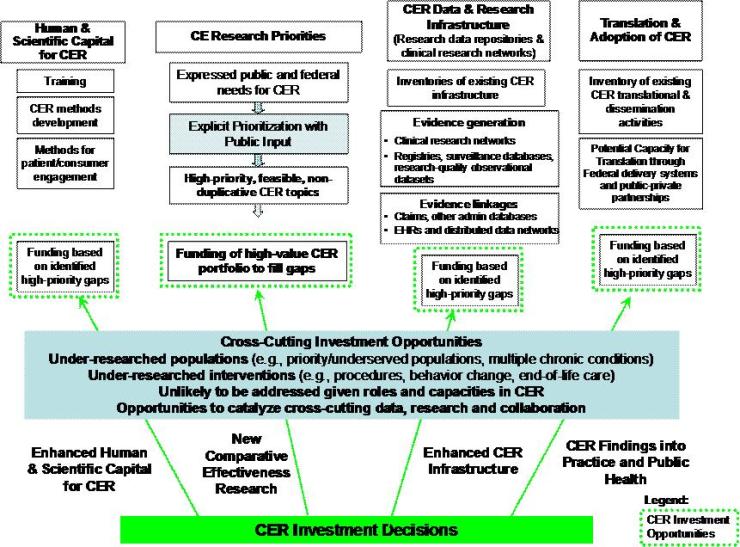Draft Definition, Prioritization Criteria, and Strategic Framework for Public CommentDraft Definition of Comparative Effectiveness Research for the Federal Coordinating CouncilComparative effectiveness research is the conduct and synthesis of systematic research comparing different interventions and strategies to prevent, diagnose, treat and monitor health conditions. The purpose of this research is to inform patients, providers, and decision-makers, responding to their expressed needs, about which interventions are most effective for which patients under specific circumstances. To provide this information, comparative effectiveness research must assess a comprehensive array of health-related outcomes for diverse patient populations. Defined interventions compared may include medications, procedures, medical and assistive devices and technologies, behavioral change strategies, and delivery system interventions. This research necessitates the development, expansion, and use of a variety of data sources and methods to assess comparative effectiveness. Draft Prioritization Criteria for Comparative Effectiveness ResearchThreshold Minimal Criteria (i.e. must meet these to be considered)
Prioritization Criteria The criteria for scientifically meritorious research and investments are:
Submit feedback to the Federal CER Council concerning the draft definition and prioritization criteria of comparative effectiveness research. Draft Comparative Effectiveness Research Strategic FrameworkThe Federal Coordinating Council for Comparative Effectiveness Research (CER) was charged with coordinating comparative effectiveness research across the Federal government and making recommendations for priorities for the funds to be allocated by the Secretary of Health and Human Services. After completing the draft definition and criteria for prioritization of potential CER investments, the Council recognized the need to develop a strategic framework for CER activity and investments to categorize current activity, identify gaps, and inform decisions on high priority recommendations. This framework represents a comprehensive, coordinated approach to CER priorities. It is intended to support immediate decisions for investment in CER priorities and to provide a comprehensive foundation for longer-term strategic decisions on CER priorities and the related infrastructure. At the framework’s core is responsiveness to expressed needs for comparative effectiveness research to inform health care decision-making by patients, clinicians, and others in the clinical and public health communities. The framework will be supported by detailed inventories of Federal CER activities and research/data infrastructure, and a priority setting approach. This organizing framework fosters consideration of the balance of activities and priority themes, focuses on the most pressing needs expressed by patients and clinicians, and allows identifying and addressing gaps in the current landscape of CER. CER investments and activities can be grouped into four major categories:
Furthermore, investments or activities related to a specific theme can cut across these categories. The themes are cross-cutting since they may include research, human and scientific capital, CER data infrastructure, and/or translation/adoption. These themes could include:
Together, these activities and themes make up the “CER Strategic Framework” (see figure). These two slides give a visual representation of the framework. Across the top are columns for the four categories of CER investments and activities. In addition, there are horizontal Cross-cutting Priority Themes that span across the four columns. The second slide shows that the foundation of each of the activities is an inventory and evaluation of current activity. This allows identification of high priority gaps for activities and cross-cutting themes, which is demonstrated on this second slide. Maintaining an inventory and ongoing evaluation of government and private sector, when possible, investments and programs in CER across these activities and themes is critical to this framework’s value in decision-making. Once an initial inventory is complete, this framework will help to identify gaps in current federal activities and investments, and inform investment opportunities for the Recovery Act funds allocated to the Secretary. The Council welcomes public input on this Strategic Framework for CER. Below is the visual representation with explanation.
Figure 1 
Figure 2 
Detailed figure descriptions of draft Strategic Framework The title of the first figure is “Strategic Framework”. It visually represents the intersection of the groups of major activities and the cross-cutting themes. The major activities are represented as columns across the page. The columns from left to right are Research, Human & Scientific Capital, CER Data Infrastructure, and Translation and Adoption of CER. To the left of the columns is a label that reads “Cross-cutting priority themes”. These themes are represented as 3 ovals that cover each of the four major activity columns. The ovals are labeled Priority Populations, Priority Conditions, and Types of Interventions. The orthogonal orientation of the ovals to the columns represents the intersection of the areas of major activity and the cross-cutting themes. A callout box on the figure indicates that “Specific investments can be made within a single category, or be cross-cutting in one of the priority themes”. The title of the second figure is “Overview: Framework for Coordinated, Comprehensive Federal Investment in CER”. This figure depicts the major activity areas again as columns, but here the content of the figure highlights the process of arriving to specific CER investment decisions in each area. In this figure, the columns of the major activity areas are, from left to right:
The process steps are listed underneath each of the major activity area headings. The final process step in each column represents a CER investment opportunity. The process steps, respective to the above order of columns, are:
At the base of the four columns is a box that reads “CER Investment Decisions”. Arrows emanate from the box to each of the four columns, representing the investment that could potentially go to each major activity area. The labels on the arrows describe the impact of investment in each major activity area and are, from left to right:
Again, as in the previous figure, the cross-cutting themes, or investment opportunities, are represented as a box that horizontally spans all four columns. The text in the box reads: Cross-Cutting Investment Opportunities:
Submit feedback to the Federal CER Council concerning the draft strategic framework. |
|







